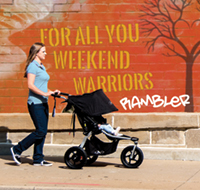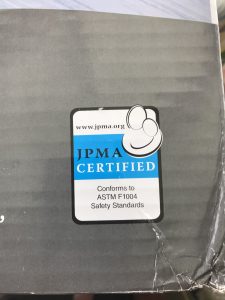
The BOB Rambler is new for 2018
Baby products, including diapers, are a 9 billion dollar annual industry in the U.S. (that doesn’t include apparel and toys). That can only mean one thing: There’s a lot to choose from!
The downside? When deciding which baby products to buy and register for, it’s easy to feel overwhelmed. Stroller shopping, for example, can make your head spin. “Choosing a stroller is such a daunting task for any of us now, even in the industry,” says Kelly Mariotti, the executive director of the Juvenile Products Manufacturers Association (JPMA) “There are so many great options.”
What’s hot? What’s not? Whether you’re registering for baby products or paying the tab yourself, Babyproductsmom chatted Mariotti to help you make “cents” of it all!
BPM: What’s trending in baby gear now?
KM: We’re in an era of innovation. We’re seeing a lot of things that are very new, such as the repurposing of tech innovations into our industry as it pertains to parenting. Products with sensors and connectivity.
BPM: Like the CYBEX Sirona M with SensorSafe 2.0? This convertible car seat (from kiddos 5 to 65 pounds) features a sensor built in to the chest clip that helps you monitor your child’s wellbeing through your cellphone. It will alert you if you accidently leave your child in the car or if your child unbuckles herself or if the back seat gets too warm.
KM: We’re also seeing a lot of mobility products—lots of innovation in terms of carriers or products used to travel with your baby that fold up and allow you to be portable rather than being confined to the home when you have a little one. Brands are acknowledging the way modern parents live and make it easier to be out and about.
BPM: Yes! I love the idea of products that make it easy for parenting to be more mobile. For example, check out the 4moms breeze plus. It opens and closes with one push and pull.
And the Baby K’tan Weekender diaper bag. It features nine compartments, a cooler pocket, a built-in wet bag and an anti-bacterial changing pad. You can truly live out of it!
KM: Strollers have gotten lighter too and even easier to open, close and carry.
BPM: So true! Check out the Diono Traverse. It’s only 12 pounds!
Each of these products are finalists for JPMA’s 2018 Innovation Awards Competition. These products available or actually going to be produced and marketed, Mariotti says.
BPM: Speaking of trends, which have come and gone? What’s out in baby gear now?
KM: There was a period when the convertible crib—crib to college—really dominated the market. It came on very quickly. But statistically, manufacturers found out that most parents didn’t actually convert the product. They would use a convertible for that second child, but they didn’t necessarily want a piece of furniture they were going to have to live with for the next 20 years.
Convertible cribs are still out there, but you don’t see it as a must have anymore. You see a lot more of the traditional cribs.
KM: We’re also seeing a lot fewer full nursery suites and the ability to customize the room more with different pieces—pieces you can mix and match based on your needs.
We’re also seeing some interesting bassinet and cradle type products, first sleep products. Most parents want to provide a sleep surface for the baby before moving into the crib. We don’t recommend bed sharing. But a product that would allow the baby to be close by, a bassinet, a cradle, a Pack N play is fine.
BPM: Like the HALO Bassinet twin sleeper? I know the American Academy of Pediatrics and First Candle recommend room sharing for the first six months, if not the first year. So, there’s no need to have the nursery ready to go as soon as your baby is born. You’ve got months to do up the nursery—or continue to tweak it.
KM: Yes, the development of the nursery can come a bit later.
KM: Baby boxes are an emerging trend in terms of first sleep surfaces, too.
BPM: What about safety?
KM: There’s a continued drive to build safety into the products from the engineering level up, and really anticipating the way parents and children will use them–being proactive about design that anticipates use patterns. We continue to see more commitment to safety every year. The industry is very interested in creating a scenario where parents don’t have to worry about safety because it’s so baked into the product.
BPM: Safety baked into products? I like the sound of that!
BPM: How do you feel about consumers doing a lot of their baby gear shopping online?
Personally, I like going to stores and figuratively kicking the tires on the strollers and literally taking them for a spin—and folding and unfolding the high chairs to see how each that would be in the real world for my customers. (Confession: I do a lot of baby gear shopping because I rent gear to grandparents and traveling parents in my area—Connecticut and NYC–through Babierge.)
KM: In large numbers, more consumers are shopping online. But parents still want to touch and feel products and talk to experts and learn how to use them. It’s very hard to narrow down your options when you’re looking at online solutions or to develop a relationship with a brand.
BPM: So true. I always recommend that new parents, especially, spend time with products in the store before registering for them or buying online–if they can. In addition to local baby boutiques, there’s Target, Walmart, Buy Buy Baby and Bed Bath and Beyond. TJ Maxx has some great baby bargains, too!
While you’re shopping, look for the JPMA seal

JPMA seal
JPMA’s voluntary certification program assures you that products are tested to the highest safety standards that exist, which encompasses federal regulatory requirements down to voluntary requirements that the program holds out as best practices in terms of the design and production of product.
You can use the certification program as verification that the company is serious about safety. “The seal makes it so parents don’t have to worry about safety. They can pick products based on fashion, weight or portability, the things that are really going to impact their lifestyle,” Mariotti says.
Updated: March 2018







Leave a Reply